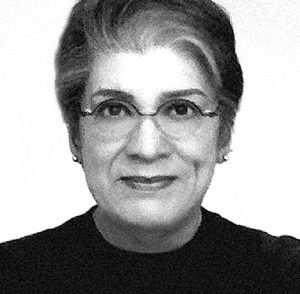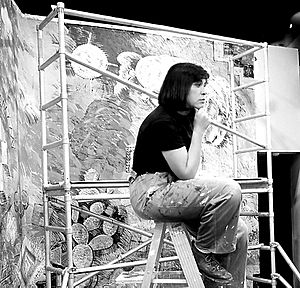Judithe Hernández facts for kids
Judithe Hernández (born 1948) is an American artist and teacher. She is famous for her murals, pastel art, and paintings. She helped start the Chicano art movement and was a member of the art group Los Four. She lives in Los Angeles, California now. She used to live in Chicago.
She became well-known in the 1970s for her murals. Over time, her art changed. Now, she mostly creates art on paper, especially with pastels. Her work often includes images from native cultures. It also explores ideas about how boys and girls are expected to act in society.
In 1974, she became the fifth member of Los Four. This was an important art group from East Los Angeles. She was the only woman in the group. Other members included Carlos Almaraz, Frank Romero, Robert de la Rocha, and Gilbert Luján. Later, she was briefly part of another art group called Centro de Arte Público. She worked with artists like Barbara Carrasco and Dolores Guerrero-Cruz. Judithe Hernández was involved in organizing Chicano artists as early as 1970. She once said that she was often the only female artist at meetings. Other women there were usually girlfriends or wives, not active artists.
Contents
Early Life and Art Education
Judithe Hernández was born in 1948 in Los Angeles, California. She went to Otis College of Art and Design. She earned her first art degree there in 1972. She then got her master's degree in 1979.
When she started at Otis College in 1969, only five Mexican-American students were enrolled. In 1972, while studying, she met her classmate, Carlos Almaraz. Through their friendship, she was invited to join the Los Four art group in 1974.
At Otis College, Hernández learned drawing from the famous African-American artist Charles White. He became a mentor and greatly influenced her art. Hernández believes her success comes from teachers and professors. They saw her talent and encouraged her art career.
In 1971, Hernández worked as an illustrator for the Aztlán Journal. This journal was published by the UCLA Chicano Studies Research Center. She illustrated the first poetry book by the famous poet Alurista, called Floricanto en Aztlán. In 2013, a special 40th-anniversary edition of the book won three awards. These were given at the International Latino Book Awards.
Her Art Career
Starting in the 1970s
After college, Judithe Hernández and Carlos Almaraz worked together. They helped El Teatro Campesino and the United Farm Workers (UFW). They also joined Concilio de Arte Popular (CAP). This group aimed to connect Chicano artists across California. Art groups like the Royal Chicano Air Force and Galería de la Raza were part of CAP. Artists from Chicano Park also joined in the 1970s.
In 1981, she and seven other Chicano muralists painted murals for an exhibition. It was called The Murals of Aztlán at the Craft and Folk Art Museum. Some critics said they were losing their cultural identity. Hernández disagreed. She said that changes in her art showed personal and professional growth.
In July 1989, Chicano art was shown in Europe for the first time. The exhibition was called Les Démon des Anges in Nantes, France. It included sixteen Chicano artists, three of whom were women. This event made Hernández's art known around the world.
Moving to Chicago (1980s-2000s)
In the early 1980s, Hernández moved to Chicago. She lived there for over 25 years. She returned to Los Angeles in 2010. Her last big show in Chicago was at the National Museum of Mexican Art. It was called La Vida Sobre Papel and opened in January 2011. The show featured several new series of her work. A newspaper, the Chicago Weekly, noted her skill and her message. Her art showed that "being human is hard, a woman harder, and life as a Latina occasionally downright grisly."
Public Art and Recognition (2000s-2010s)
In 2011, Hernández was one of the artists honored in Pacific Standard Time: Art in L.A., 1945–1980. This was a big art event in Los Angeles, supported by the Getty Foundation. In 2012, Hernández received two major awards. She got the C.O.L.A. Fellowship for 2013. She also won a special project to create public art for the Metro EXPO LINE. This art is at the Downtown Santa Monica station.
The Expo Line Downtown Santa Monica station opened on May 20, 2016. Hernández designed 24 mosaic glass panels for the station. These panels are called "L.A. Sonata." They show the passing of the day and seasons. They use many cultural symbols to represent Los Angeles's diverse people. This train line is expected to be one of the busiest in the U.S.
In 2013, Hernández was one of 72 artists chosen for a major exhibition. It was at the Smithsonian American Art Museum. The show was called "Our America: The Latino Presence in American Art." It featured art from their permanent collection. After closing in Washington D.C., the exhibition traveled to other museums. These included the Crocker Museum in California and the Utah Museum of Fine Arts. In 2017, her work was again part of the Getty Foundation's Pacific Standard Time LA/LA. This event explored how Latin American art influenced Los Angeles art. Her artwork "The Purification" was chosen to promote the event.
Over her 50-year career, her art has been shown and bought by many important places. These include the Museum of Modern Art and the Smithsonian American Art Museum. She has received awards like the University of Chicago Artist-in-Residence. In 2018, a famous art critic, Christopher Knight, praised her work. He wrote that her art is "churned by her marvelous color sense."
In 2018, the National Museum of Mexican Art gave her the Sor Juana Legacy Award. This was for her "outstanding lifetime contributions to arts." She also became the first American-born Latina to have a solo show at the Museum of Latin American Art. Her work "La Virgen del la Oscuridad" became a main image for the Natural History Museum of Los Angeles County. In 2019, she created a new mural. This seven-story mural, "La Nueva Reina de Los Angeles," is in downtown Los Angeles.
She is married to designer Morton Neikrug. They have one daughter.
Awards and Collections
Judithe Hernández received the Anonymous Was A Woman Award in 2021. The City of Los Angeles gave her an Individual Artist Fellowship in 2013. In 2011, she was an artist in residence at the University of Chicago. She worked in the Center for the Study of Race, Politics, and Culture.
Her art is in many public collections. These include the Museum of Modern Art (MoMA) and the Crocker Art Museum. Her work can also be found at the National Museum of Mexican Art and the Smithsonian American Art Museum.
Solo Exhibitions
- 2021 – Judithe Hernández: Dreams on Paper, Monica King Contemporary, New York City, New York
- 2018 – A Dream is the Shadow of Something Real, Museum of Latin American Art (MOLAA), Long Beach, California
- 2011 – La Vida Sobre Papel, National Museum of Mexican Art, Chicago, Illinois.
- 2010 – What Dreams May Come / Qué Sueños Quizás Vengan, Woman Made Gallery, Chicago, Illinois
- 1983 – Judithe Hernández: Works on Paper, Cayman Gallery, New York City, New York
- 1980 – A Decade of a Woman's Work, Solart Gallery, San Diego, California
- 1979 – Virgen, Madre, Mujer: Imágenes de la Mujer Chicana, Casa de la Raza, Santa Barbara, California
- 1978 – Mi Arte, Mi Raza, Los Angeles Municipal Art Gallery, Los Angeles, California
Group Exhibitions
This is a list of some group exhibitions where Hernández's art was shown:
- 2020 – Printing the Revolution! The Rise and Impact of Chicano Graphics, 1965 to Now. Smithsonian American Art Museum, Washington DC
- 2019 – LIFE MODEL: Charles White and His Students, Los Angeles County Museum of Art (LACMA), Los Angeles, California
- 2017 – Judithe Hernández & Patssi Valdez: Two Paths One Journey, Millard Sheets Center for the Arts, Pomona, California
- 2015–2016 – Our America: The Latino Presence in American Art, (traveling group exhibition), Delaware Museum of Art, Allentown Art Museum, Museum of Fine Arts, St. Petersburg, Arkansas Arts Center, Utah Museum of Fine Arts
- 2009 – Judithe Hernández and Sergio Gomez: Through the Labyrinth, President's Gallery, Chicago State University, Chicago, Illinois
- 2009 – Feminist Ecology: Women and the Earth, Koehnline Museum, Chicago, Illinois
- 1989–1990 – Les Démon des Anges, (traveling group exhibition), Centre de Recherche et de Développement Culturel (CRDC), Nantes, France; Centro de Arte Contemporaño Santa Monica, Barcelona, Spain; Espace Lyonnais d'Art Contemporain, Lyon, France; Kulturerhuset, Stockholm, Sweden
- 1978 – The Aesthetics of Graffiti, curated by Rolando Castellón, San Francisco Museum of Modern Art (SFMoMA), San Francisco, California
- 1974 – Los Four en Longo, Long Beach Museum of Art, Long Beach, California
Public Artworks
| Date | Title | Artist(s) | Type | Location | Notes |
|---|---|---|---|---|---|
| 2019 | La Nueva Reina de Los Angeles | Judithe Hernández | mural | La Plaza Village, Broadway at Hollywood Freeway, Los Angeles, California | |
| 2016 | Judithe Hernández | mural | EXPO Line, Downtown Santa Monica station, Santa Monica, California | ||
| 1982 | Recuerdos de Ayer, Sueños de Mañana (Remembrances of Yesterday, Dreams of Tomorrow) | Judithe Hernández | mural | El Pueblo de Los Angeles Historic Monument, Brunswig Garage, Spring Street, Los Angeles, California | This Los Angeles Bicentennial Mural features La Reina de Los Ángeles (Queen of the Angels). |
| 1977 | Adelita or La Adelita | Carlos Almaraz, Judithe Hernández | mural | Ramona Gardens Housing Project, East Los Angeles, California | A woman with a red scarf is in the center. Text in Spanish is on both sides. Signed by "Los Four". |
| 1977 | Ave 43 Mural | Carlos Almaraz, Frank Romero, Leo Limon, Judithe Hernández | mural | Highland Park, Los Angeles, California | |
| 1976 | El Mundo del Barrio Sotel | Judithe Hernández | mural | Restored in 1997, but taken down in 2002. | |
| 1975 | United Farmer Workers (UFW) mural | Carlos Almaraz, Judithe Hernández | mural | 2nd Constitutional Convention, La Paz, California | |
| 1974 | Judithe Hernández | mural | El Teatro de la Vida, Century Playhouse Theater, Los Angeles, California | Funded by the National Endowment for the Arts. |



